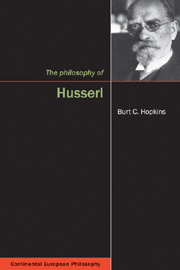Book contents
- Frontmatter
- Contents
- Acknowledgements
- Abbreviations
- Prolegomenon: Husserl's turn to history and pure phenomenology
- I Plato's and Aristotle's theory of eidē
- 1 Plato's Socratic theory of eidē : the first pillar of the ancient precedent to pure phenomenology
- 2 Plato's arithmological theory of eidē : the second pillar of the ancient precedent to pure phenomenology
- 3 Aristotle's criticism of Plato's theory of eidē : the third (and final) pillar of the ancient precedent to pure phenomenology
- II From descriptive psychology to transcendentally pure phenomenology
- III From the phenomenology of transcendental consciousness to that of monadological intersubjectivity
- IV From monadological intersubjectivity to the historical a priori constitutive of all meaning
- V The unwarranted historical presuppositions guiding the fundamental ontological and deconstructive criticisms of transcendental philosophy
- Epilogue: Transcendental-phenomenological criticism of the criticism of phenomenological cognition
- Coda: Phenomenological self-responsibility and the singularity of transcendental philosophy
- Notes
- Bibliography
- Index
2 - Plato's arithmological theory of eidē : the second pillar of the ancient precedent to pure phenomenology
from I - Plato's and Aristotle's theory of eidē
- Frontmatter
- Contents
- Acknowledgements
- Abbreviations
- Prolegomenon: Husserl's turn to history and pure phenomenology
- I Plato's and Aristotle's theory of eidē
- 1 Plato's Socratic theory of eidē : the first pillar of the ancient precedent to pure phenomenology
- 2 Plato's arithmological theory of eidē : the second pillar of the ancient precedent to pure phenomenology
- 3 Aristotle's criticism of Plato's theory of eidē : the third (and final) pillar of the ancient precedent to pure phenomenology
- II From descriptive psychology to transcendentally pure phenomenology
- III From the phenomenology of transcendental consciousness to that of monadological intersubjectivity
- IV From monadological intersubjectivity to the historical a priori constitutive of all meaning
- V The unwarranted historical presuppositions guiding the fundamental ontological and deconstructive criticisms of transcendental philosophy
- Epilogue: Transcendental-phenomenological criticism of the criticism of phenomenological cognition
- Coda: Phenomenological self-responsibility and the singularity of transcendental philosophy
- Notes
- Bibliography
- Index
Summary
Dialectically imageless investigation of eidē : Plato's “unwritten teachings”
The dialogues' second account of the eidē is neither readily apparent nor Socratic. In place of the dramatic figures of the philosopher Socrates and various non-philosophers, the figure of the unnamed philosopher from Elea (the “Stranger”) and the accomplished mathematician Theaetetus pursue to its end – to be sure in the presence of and at the initiative of Socrates – the “right use” of the technē proper to counting and calculation for redirecting the whole soul to the source of being and truth. In other words, they complete in deed what is merely prescriptive in the Socratic account of the eidē. Their dialectically imageless investigation of the eidē, and, more precisely, of the “greatest” (most original) “kinds” (genē), is presented in a manner in which the inexactness of the images belonging to Socratic myth is superseded by the exactness of number and the one. (In the Cratylus, Socrates calls attention to the crucial difference in exactness between an image and a number by pointing out that an image necessarily lacks attributes of its original, because otherwise it would not be an image but another original, while a number necessarily cannot be missing any part and remain what it is.) Because of their greatest originality, each of these five genē, “itself by itself” (auto kath' auto), is shown as the necessary presuppositions for the “intelligibility” of any eidos.
- Type
- Chapter
- Information
- The Philosophy of Husserl , pp. 34 - 59Publisher: Acumen PublishingPrint publication year: 2010

